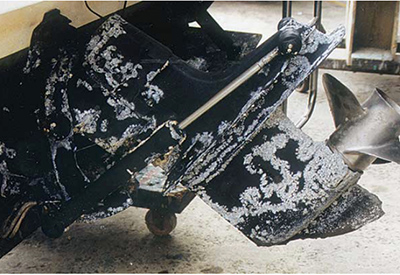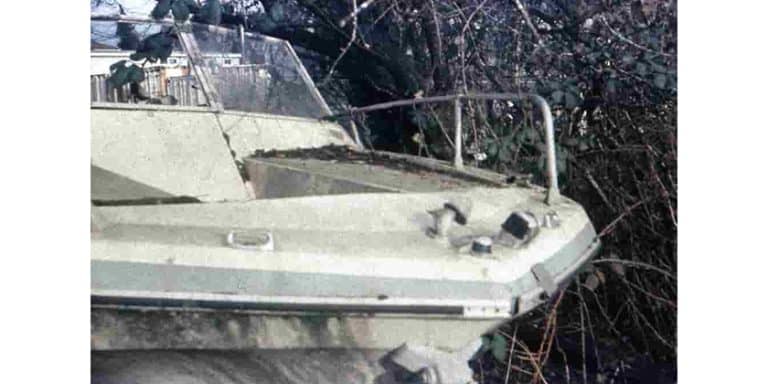Ask Andrew: Corrosion – Part 1

Aug 26, 2021
galvanic corrosion damage to a stern-drive
It’s a scary thought – but whether your boat is made of wood, fiberglass, aluminum or composite – it’s slowly deteriorating under you. Part of this is the nature of the marine environment: Sun, moisture, waves, wind, movement and vibration all contribute to components breaking down.
But there are other factors that are much more concerning and act at a significantly faster rate that the environment can take credit for. One of these is commonly spoken of, but not terribly well understood: Corrosion.
As boaters, we’re concerned with two main types of corrosion: Galvanic and Stray-Current. This edition will focus on galvanic corrosion – in two weeks, stay tuned for info on stray-current.
First, lets be clear on what we’re talking about (because there are many misnomers and words that are used interchangeably for different things): Corrosion isn’t as simple as rust It’s not delamination or rot. It’s not caused by waves, water or sun. It can’t be stopped by sanding, coatings and paints. Corrosion is defined as the ‘the gradual destruction of materials (usually a metal) by chemical and/or electrochemical reaction with their environment’. Galvanic is separated from Stray-current, by the manner in which this gradual destruction takes place.
Corrosion can be looked at in a less encyclopedic way: It’s the return of a refined metal’s state to it’s more base form. The metals we use in boat building (Steel, bronze, brass, aluminum) have been refined to their workable form. Corrosion is the natural process of these refined metals returning to a more stable form (oxides, hydroxides, carbonate or sulfide).
 The important take-away here is that this is a natural occurring process – and refined metals will always work to return to these more chemically stable forms.
The important take-away here is that this is a natural occurring process – and refined metals will always work to return to these more chemically stable forms.
One such process is called ‘galvanic corrosion’ – this is where one metal corrodes preferentially when it is in electrical contact with another. Another way that the scientists define galvanic corrosion is ‘when dissimilar metals and alloys have different electrode potentials, and when two or more come into contact with an electrolyte, one meal acts as the anode, and the other as cathode’
I’m not a scientist – so let me break this down in the way that makes sense to the average boater: when two different metals immersed in sea water, the stronger metal will steal electrons from the weaker metal. The electrons that are stolen, show up over time as pitting or corrosion on the weaker metal. (If you’re a scientist reading this, please forgive the oversimplification).
Which metal is the stronger metal? This can be found by referencing a galvanic chart, where metals are listed from strongest to weakest in order, so that they can be compared and galvanic corrosion can be predicted.
Modern boats have the perfect storm to allow galvanic corrosion to occur: There are a number of metals, of different strengths (therefore one acting as the anode, another acting as a cathode), the a boat is immersed in an electrolyte (water). Reactions can take place between bronze through-hulls, steel screw-heads, steel prop shafts, aluminum propellers, steel and aluminum outdrives and components. Even the copper-based antifouling paints applied annually can create a reaction. The interactions between these metals underwater will allow corrosion to take place.
But, take heart. This is a known reaction, with results that can be predicted and quantified. A number of safeguards were already in place on your boat by the manufacturer before it was launched – it’s your job to help and maintain these safeguards so that the natural galvanic corrosion that takes place, can be kept at bay.
 anodes placed on a vessel’s metal shaft and rudder.
anodes placed on a vessel’s metal shaft and rudder.
Here are a few ways that modern boats are protected:
1) The use of sacrificial anodes. This is when a ‘weak’ metal (low on the galvanic chart) like zinc or magnesium is purposefully placed in locations where corrosion is likely to occur so that it can be ‘sacrificed’ in place of the more important underwater metal components of the boat. In essence, by adding sacrificial anodes, youre making it easy for corrosion to happen – but doing it in a controlled way. The key here is to choose the correct type of anodes, and to replace them on time so that the more important parts of your boat don’t become the anode!
2) Electrically insulating metals from each other, by using non-conductive materials between them. Covering screw-heads with a dab of caulking, using grease to coat metal components, or fitting moulded plastic over exposed metals can greatly reduce the likelihood of corrosion occurring.
3) Cathodic protection systems – one example is the Mercathode system found on many Mercruiser stern-drive engines. This system used the boat’s battery to run a very low level current through the underwater electrical components. Each component is bonded to the adjacent section to allow the low-level current to complete a full circuit. You’ll note that modern outboard engines and stern-drives have small gauge metal wires running from the transom assembly to the main drive, to the trim rams. This is in an effort to oppose the corrosive galvanic current.
4) Using similar metals. Note that galvanic corrosion only occurs when dissimilar metals are immersed in an electrolyte. If all underwater components are made from the same metal, the chemical reaction won’t take place. There’s a caveat, however: you have to be aware of the underwater metals on the docks, chains, anchors and adjacent boats to ensure that this is effective
Next edition, more on corrosion – we’ll focus on stray-current corrosion: What it is and how to protect against it.
 Andrew McDonald is the owner of Lakeside Marine Services – a boat repair/maintenance firm based in Toronto. Andrew has worked in the marine industry for 12 years and is a graduate of the Georgian College ‘Mechanical Techniques – Marine Engine Mechanic’ program.
Andrew McDonald is the owner of Lakeside Marine Services – a boat repair/maintenance firm based in Toronto. Andrew has worked in the marine industry for 12 years and is a graduate of the Georgian College ‘Mechanical Techniques – Marine Engine Mechanic’ program.
Questions or comments for Andrew? Email him directly via: askandrew@lakesidemarineservices.ca




























